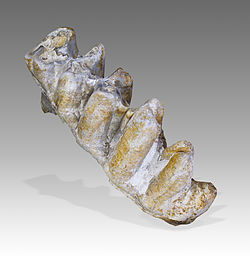Portal:Paleontology
|
The Palaeontology Portal
Introduction Paleontology (/ˌpeɪliɒnˈtɒlədʒi, ˌpæli-, -ən-/ PAY-lee-on-TOL-ə-jee, PAL-ee-, -ən-), also spelled palaeontology or palæontology, is the scientific study of life that existed prior to the start of the Holocene epoch (roughly 11,700 years before present). It includes the study of fossils to classify organisms and study their interactions with each other and their environments (their paleoecology). Paleontological observations have been documented as far back as the 5th century BC. The science became established in the 18th century as a result of Georges Cuvier's work on comparative anatomy, and developed rapidly in the 19th century. The term has been used since 1822 formed from Greek παλαιός ('palaios', "old, ancient"), ὄν ('on', (gen. 'ontos'), "being, creature"), and λόγος ('logos', "speech, thought, study"). Paleontology lies on the border between biology and geology, but it differs from archaeology in that it excludes the study of anatomically modern humans. It now uses techniques drawn from a wide range of sciences, including biochemistry, mathematics, and engineering. Use of all these techniques has enabled paleontologists to discover much of the evolutionary history of life, almost back to when Earth became capable of supporting life, nearly 4 billion years ago. As knowledge has increased, paleontology has developed specialised sub-divisions, some of which focus on different types of fossil organisms while others study ecology and environmental history, such as ancient climates. (Full article...) Selected article on the prehistoric world and its legacies
Dimetrodon is an extinct genus of synapsid that lived during the Early Permian, around 299–270 million years ago (Ma). It is a member of the family Sphenacodontidae. The most prominent feature of Dimetrodon is the large sail on its back formed by elongated spines extending from the vertebrae. It walked on four legs and had a tall, curved skull with large teeth of different sizes set along the jaws. Generally reptile-like in appearance and physiology, Dimetrodon is nevertheless more closely related to mammals than it is to any living reptilian group, though it is not a direct ancestor of any mammals. Most fossils have been found in the southwestern United States, the majority coming from a geological deposit called the Red Beds in Texas and Oklahoma. More recently, fossils have been found in Germany. Over a dozen species have been named since the genus was firstdescribed in 1878.
Dimetrodon was probably one of the top predators in Early Permian ecosystems, feeding on fish and tetrapods, including reptiles as well as amphibians. Smaller Dimetrodon species may have had different ecological roles. The sail of Dimetrodon may have been used to stabilize its spine or to heat and cool its body as a form of thermoregulation. Some recent studies argue that the sail would have been ineffective at removing heat from the body, and was more likely used in sexual display. (see more...) Did you know?

General images -The following are images from various paleontology-related articles on Wikipedia.
Selected article on paleontology in human science, culture and economics
Charles Darwin (12 February 1809 – 19 April 1882) was an English naturalist and geologist, best known for his contributions to evolutionary theory. He established that all species of life have descended over time from common ancestors, and in a joint publication with Alfred Russel Wallace introduced his scientific theory that this branching pattern of evolution resulted from a process that he called natural selection, in which the struggle for existence has a similar effect to the artificial selection involved in selective breeding.
His five-year voyage on HMS Beagle established him as an eminent geologist whose observations and theories supported Charles Lyell's uniformitarian ideas. Darwin later published his theory of evolution with compelling evidence in his 1859 book On the Origin of Species, overcoming scientific rejection of earlier concepts of transmutation of species. By the 1870s the scientific community and much of the general public had accepted evolution as a fact. However, many favoured competing explanations and it was not until the emergence of the modern evolutionary synthesis from the 1930s to the 1950s that a broad consensus developed in which natural selection was the basic mechanism of evolution. In modified form, Darwin's scientific discovery is the unifying theory of the life sciences, explaining the diversity of life. In recognition of Darwin's pre-eminence as a scientist, he was honoured with a major ceremonial funeral and buried in Westminster Abbey, close to John Herschel and Isaac Newton. Darwin has been described as one of the most influential figures in human history. (see more...) On this day...Selected image
CategoriesTopicsGeneral - Paleontology - Fossil - Evolution - Extinction Quality ContentFeatured paleontology articles
- Achelousaurus
- Acrocanthosaurus
- Albertosaurus
- Allosaurus
- Amargasaurus
- Ankylosaurus
- Apatosaurus
- Archaeopteryx
- Baryonyx
- Carnotaurus
- Catopsbaatar
- Ceratosaurus
- Chicxulub Crater
- Compsognathus
- Cretaceous–Tertiary extinction event
- Daspletosaurus
- Deinocheirus
- Deinonychus
- Deinosuchus
- Dilophosaurus
- Dinosaur
- Diplodocus
- Dromaeosauroides
- Edmontosaurus
- Elasmosaurus
- Giganotosaurus
- Gorgosaurus
- Herrerasaurus
- Iguanodon
- Istiodactylus
- Lambeosaurus
- List of dinosaur genera
- Majungasaurus
- Massospondylus
- Megalodon
- Nemegtomaia
- Nigersaurus
- Opisthocoelicaudia
- Paranthodon
- Parasaurolophus
- Plateosaurus
- Psittacosaurus
- Seorsumuscardinus
- Spinosaurus
- Stegosaurus
- Stegoceras
- Styracosaurus
- Tarbosaurus
- Thescelosaurus
- Triceratops
- Tyrannosaurus
- Velociraptor
Things you can doCurrent Paleontology FACs - None yet... WikiProjectsRelated portalsAssociated WikimediaThe following Wikimedia Foundation sister projects provide more on this subject:
Discover Wikipedia using portals |









































